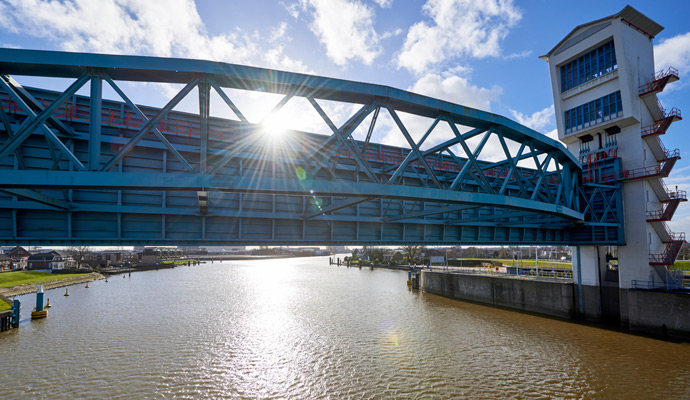Water Experts for the World
The Dutch turned adversity into a compelling economic opportunity. Other countries could do the same.
Shortly after Hurricane Sandy struck the East Coast of the United States in 2012, the U.S. Secretary of Housing and Urban Development (HUD) visited the Netherlands. Shaun Donovan had been asked to lead President Barack Obama’s Hurricane Sandy Rebuilding Task Force, aimed at the reconstruction of areas devastated not just by that hurricane, but by other natural disasters since 2011. The budget of the task force was nearly US$60 billion, and its mission was far-reaching. It would address housing, healthcare, the social and local economic impact of disaster, the overhaul of infrastructure, and preparation for other potential water-related threats in light of climate change. The storm had affected 24 states, from Florida to Maine and as far west as Wisconsin, with the most severe damage in New Jersey and New York. Sea levels were almost certain to rise again, and lowland flooding to recur, and the U.S. lacked the expertise to manage them.
Donovan’s host was Henk Ovink, deputy director general of Spatial Planning and Water Affairs at the Ministry of Infrastructure and Environment in the Hague. It was his job to show Donovan how innovative practices in the Netherlands — including water technology, finance, and public–private collaboration — had continued to hold back the floods there, and how they could do the same elsewhere.
In 2013, Donovan invited Ovink to join the task force. Ovink moved to the U.S. for several years, and as part of his efforts, cofounded (with the Rockefeller Foundation and New York University) a New York–based program called Rebuild by Design. Rebuild by Design focuses on large-scale community-led planning and disaster preparation projects for waterfront cities around the world.
“Communities can’t afford to wait until after the next hurricane or flood…to plan for the future,” according to the Rebuild by Design website. It’s a sentiment that has informed the Dutch, who not only have managed their own immense water-related challenges, but have created a role for themselves in helping others. The country has gradually built up unparalleled expertise in flood control and water management, and is now turning that expertise into an export industry. Ovink, for example, spends much of his time traveling the world to promote innovative approaches to solving water problems, often involving collaborative engagements with Dutch advisors and companies.
“When something goes wrong, you must look beyond the horizon,” says Ovink, who has since been appointed special envoy for international water affairs (also known as “water ambassador”) for the Netherlands. “You want to make sure that what you do next is also an investment in the future. You need to look at the entire system you are dealing with to get a good understanding of how all processes are interlinked: sewerage, spatial planning of a city, the functions of green areas, infrastructure, rivers.”
The Netherlands has gradually built up unparalleled expertise in flood control and water management, and is now turning that expertise into an export industry.
According to the government’s Dutch Water Technology website, the Netherlands has 125 advanced engineering and architecture businesses with global clientele, providing such services as flood control, wastewater management, desalination, flood insurance, infrastructure design, algae management, and other forms of advanced water treatment. Together with Dutch government agencies and research groups, these businesses are changing the way others think about preparing for flooding and related disasters, shifting the process from a purely technological endeavor to one that involves community building and environmentally oriented practice. And they’re setting an example for a benign neo-mercantile business model that other countries with challenges can follow, by selling the solutions they have developed over time.
Water Ways
To understand why the Netherlands has become the world’s go-to source of water management expertise, one needs only to fly over this densely populated country, with more than 17 million inhabitants, and count the number of villages and cities that are surrounded by rivers, lakes, and ocean or sea inlets. Indeed, about 26 percent of the Netherlands terrain lies below sea level (pdf), with 60 percent of the population living in those areas; about 59 percent of the country’s land is vulnerable to river flooding.
Because of this geography, water management has always been a critical policy field of this Northern European nation. For the Dutch, it comes naturally to spend money on the vast water system: On average the government sets aside more than €4 billion (more than US$5 billion) each year to keep up its defenses against high water. According to the Netherlands Directorate-General for Public Works and Water Management, an estimated 1,900 kilometers of dikes and levees are expected to be in place by 2050.
“Water management is deeply ingrained in the DNA of the Netherlands,” says Ovink. As early as the 12th century, the Dutch had established water boards (waterschappen), regional government bodies charged with managing water barriers, waterways, water levels, water quality, and sewage treatment. These boards are among the oldest forms of local government in the Netherlands.
The political groundwork paved the way for the Dutch water sector to thrive, by encouraging innovative solutions and helping bring them to scale. The most famous example is the Delta Works, a series of construction projects in the southwest area of the Netherlands, which protect a vast area of land around the Rhine-Meuse-Scheldt delta from the sea. The project was launched in 1953, just after a North Sea flood, the worst in more than a century, suddenly inundated more than 165,000 hectares (about 408,000 acres) in the Netherlands and took more than 1,800 lives.
The Delta Works consists of dams, dikes, locks, levees, and storm surge barriers. It was conceived from the beginning as a long-term project and was designed to push back seawater, reduce the complexity and length of the existing dikes, promote the natural environment where possible, and maintain local communities. Its first project, a storm barrier in the river Hollandse IJssel, opened in 1958, but the Delta Works weren’t completed until 1997 and are still continually upgraded. Among the Delta Works’ components is the world’s largest robot, the Maeslant storm surge barrier — two gates, 22 meters (72 feet) high, guarding the mouth of the Rhine and Meuse rivers. They can open and close automatically based on algorithmic calculations of the threat of storm surges. According to the American Society of Civil Engineers, the entire Delta Works is one of Seven Wonders of the Modern World, alongside the Panama Canal, the Channel Tunnel, and the Golden Gate Bridge.
Over the years, dozens of local engineering, construction, software development, and technological consulting firms, along with community and regional groups, have been involved in the Delta Works, coordinated by a national commission. “The cooperation between these different actors and tight communication between them is what characterizes the Dutch approach, and what sets it apart from any other place in the world,” says Ovink. The Delta Works is known for its emphasis on learning from experience, and for its leaders’ willingness to alter plans as they gain sophistication. For example, a closed dam design for the Schelde River, completely separating seawater from freshwater, was switched in 1976 to an open design, preserving the mixed brine environment so local fish could thrive. More recently, on what the WWF called the “historic day” of November 15, 2018, the Dutch government opened the Haringvliet dam, connecting the Rhine and Meuse rivers to the North Sea and allowing migratory fish to swim to their delta spawning grounds for the first time in 47 years. According to Ovink, “It was done in close collaboration with local farmers and citizens. Working in and on this Dutch delta never stops.”
Dutch water engineering expertise wasn’t limited to the delta. Another example is the 300-meter-long (328-yard-long) self-raising Spakenburg dike, which is typically hidden away in the sidewalk to keep the view picturesque for tourists, but which can be lifted to 80 centimeters (31 inches) by the same floodwaters it is designed to keep out. Then there’s the Eendragtspolder, a land area near Rotterdam reclaimed from the sea. It’s a patchwork of fields and streams, designed as a rowing course, and used as the site of the 2016 World Rowing Championships. There are also larger-scale reclamation programs aimed at flood reduction. Ruimte voor de Rivier (“Room for the River”) adds capacity to major flowing streams through sediment removal, dike relocation, and landscape redesign. The Coastal Weak Link program identifies vulnerable communities and builds sand dunes and beaches as tidal defenses.
Taking It Overseas
As projects like these evolved, the Dutch water technology export business naturally evolved with them. Projects like Spakenburg and Eendragtspolder are seen as models for projects in England, China, the U.S., and elsewhere. It is estimated that the annual export of Dutch water technology and knowledge has doubled since 2000, to just under €8 billion ($9.3 billion) in 2016. Interest has accelerated with the growing consciousness of climate change and its effects.
“We gain our experience in the Netherlands,” says Herman Mondeel, head of the product market business unit water management team at Witteveen+Bos, a global 1,100-employee engineering consultancy headquartered in the Dutch city of Deventer. Among its areas of expertise are (salt) groundwater control, storing freshwater in soil, spatial and climate adaptation, and urban flood management; 30 to 40 percent of its business comes from foreign clients. Sometimes with World Bank or Asian Development Bank funding, the firm is active in Dubai, Ghana, Indonesia, Kazakhstan, Singapore, and Vietnam.
Mondeel says that his firm’s business is based in part on the Netherlands’ reputation in general, not just for expertise but for its integrated approach to building solutions. “We help with process management, participative design, and quality of construction,” he says. “How do you deal with the government, but also with people who live and work in the affected areas? How do you go beyond writing up the reports, to make sure something is built?”
Designing measures that fit well in the context is an important issue. “Often we come across problems that are the result of a lack of attention,” adds Mondeel. “In Jakarta, they built a concrete two-meter-high wall to hold back the sea. But the subsidence is 10 to 15 centimeters per year, and the wall could overtop or break any moment without proper maintenance.” For the 3 million people who would be flooded if that happened, “the wall is merely bringing a false sense of security.” Dikes and dams are more appropriate for places where there is sufficient attention for maintenance.
Witteveen+Bos, starting with its understanding of public–private collaboration grounded in centuries of Dutch experience with local governance, helped the Indonesians develop a polder (a tract of reclaimed low land) that protects 100,000 people in Semarang, with its own water governance board system. “We bring an understanding that collaborations are of vital importance, to ensure that different levels of governments work well together. In a hierarchical system like Indonesia’s, that can be very difficult at first,” says Mondeel.
Another Dutch engineering consultancy, Royal HaskoningDHV, took its expertise in water management to the United States. In partnership with the Office for Metropolitan Architecture (OMA), a firm cofounded by Dutch architect Rem Koolhaas, it was selected by Rebuild by Design to help the New Jersey city of Hoboken recover from Hurricane Sandy. Located directly across the Hudson River from Manhattan, Hoboken is the fourth-densest city in the U.S., and a commuter hub for more than 50,000 people. Its housing and transit infrastructure had been badly damaged by the storm.
The resulting urban water strategy for Hoboken and surrounding areas is a comprehensive approach to managing stormwater and tidal surge, based on Dutch experience and extensive collaboration with New Jersey community leaders. The strategy has four objectives: resisting coastal storm damage, delaying flooding from rainwater runoff, storing excess water in “green infrastructure” such as rain gardens and permeable paving, and discharging drainage in a more controlled way. New elements include “hard” flood prevention structures, such as bulkheads and seawalls; “soft” landscape-based defenses such as permeable paving and rain gardens; improvements to wastewater and drinking water infrastructure; and urban planning efforts to mix, for example, living space with greenery.
“The Netherlands is a true laboratory for innovation,” says Lisette Heuer, global director of flood resilience for Royal HaskoningDHV. “We try out ideas, and if they work here, we can explore applying similar solutions in other countries provided a fit with local context.” At the same time, she says, the close connection with local stakeholders is critical. “The Hoboken project became a team effort, where the borders of a particular company were no longer relevant. We created workshops, for example, with stakeholders from all parts of the community, all at the table working out potential solutions. That can’t be achieved by only one company or agency, but it also requires a team from multiple places who can act as if they belong to one company.”
Local engagement was also important, Heuer adds, because the consulting firms eventually leave. “These big infrastructural projects are often highly complex. How do you make sure they are properly maintained? You need to see it take root in the local environment,” she says.
The Rebuild by Design work is still underway. Indeed, the Hoboken project was one of seven winners of a 2013 competition conducted by Donovan’s Hurricane Sandy task force, which invited designers to develop innovative design solutions for resilient rebuilding. There were 148 entrants from around the world; Dutch expertise was active in five of the seven selected. A key part of each winning project was local community engagement, a priority that came naturally to the Dutch, with their local water management heritage. “This goes beyond getting local stakeholders to support something you have already created in your ivory tower,” says Ovink. “That is how projects grow sour, a mistake that happens all over the world.” Instead, he says, the Dutch start with true cooperation, with local communities designing solutions together with the professionals. “The knowledge of local communities is just as valuable as the knowledge of an expert. Rebuild by Design was unique, because it forced the federal government to sit down with communities, businesses, NGOs, local and state governments, research institutes, and schools,” he says. “You need them all.”
Following the Dutch Example
Throughout the world, other countries have also learned lessons through adversity. They might be dealing with aging populations, as they are in Japan; resource management, as they are in Canada; cyberattack, as in Estonia; water scarcity, as in much of the Middle East; or natural disasters, such as forest fires, earthquakes, or tsunamis. As extreme weather increases in frequency and urgency, threats are likely to proliferate, and thus so are opportunities. Manufacturers, for example, are already aware of the climate-related risks to supply chains — when a hurricane hits a manufacturing region where one component of an electronic device is made, all production of that device may cease.
The Dutch are well positioned to benefit economically from adversity. As Heuer points out, in the 2018 World Economic Forum Global Risks Report (pdf), four out of the five threats rated high in both likelihood and impact had a direct link to water. (These were extreme weather events, natural disasters, failure to adapt to climate change, water crises, and cyberattack.) As business and government leaders become aware of the dangers of ignoring these risks, they become much more sensitive to the value of proactive, preventive solutions to their potential water problems.
“Throughout the business world,” Heuer says, “interest is growing. For example, many companies are asked to visualize their water risks in an end-of-year report and to include them in their financial balance.” The same concerns are evident in the way insurance companies evaluate the risks in their portfolios. Concerns are growing rapidly enough that Ovink estimates the Dutch water solutions business sector could multiply fourfold in just a few years — if it had the requisite capacity. In the process, it would evolve to coordinate other challenges: food, energy, waste, health, and ecological improvement initiatives all involve water management. (One country generating similar business opportunities is Singapore, which is exporting its expertise in managing freshwater scarcity.)
Imagine that you were in a country with a similar body of knowledge. How could you build an exportable business? There is a great deal to learn from the Dutch example.
• “Cultivate innovation and experimentation over time,” says Heuer. The Dutch took the long view from the beginning, recognizing that it would take years, and much participative collaboration, to develop the necessary knowledge.
• Monitor the needs of other locales. “You need to travel and see what governments want,” says Mondeel. This includes assessing the readiness of the general market. “If a certain problem is suddenly prominent, so that business and government leaders are talking about it, you should probably enter. But if other players are already dominant, you need to stay away.”
• Link your efforts to those of other companies and to your home country’s organizations. Both Royal HaskoningDHV and Witteveen+Bos, for instance, work closely with the Netherlands Water Partnership (NWP), a network of organizations that aim to address global water issues and promote Dutch expertise in this field. “NWP has established links between businesses in the Netherlands and abroad,” says Mondeel. Active in 40 countries, it has 181 members, including businesses, government agencies, universities, think tanks, and nongovernmental organizations.
• Promote transformative solutions with multiple participants. Ovink argues that specific measures — a single technology or plant — should be seen as starting points for more significant movements. The broader your effort, the more other actors will be motivated to contribute, and add to one another’s knowledge.
• Design for sustainability. It’s not enough to build a new barrier or power plant. You have to ensure it will last over time, and continue to prevent catastrophe. This means setting up structures, such as the Dutch water boards, that force someone to pay continual attention to maintenance and improvement.
• Remain humble. Ovink is always careful to avoid lecturing people about the brilliance of the Dutch way. “There is no plane [full of] Dutch solutions, occasionally air-dropping them and expecting them to work. Those projects could easily turn out to be dysfunctional and then local people will say, ‘What did those Dutch people give us?’ Instead, you have to set up collaboration with local experts, stakeholders, and governments, where everyone can work together to develop the best answers, [which is] of course inspired by Dutch capacity and innovation,” he says. The long-ingrained Dutch predisposition to collaboration, says Ovink, naturally tends to generate “local and contextualized solutions developed with our expertise and experience. That collaborative approach strengthens the value of the solutions we provide, and their resilience and sustainability.”
The increasing complexity of global issues makes it more likely that large-scale problem solving will be an aspect of economic growth for countries around the world. As Lisette Heuer points out, work on water management is now moving from protection (dams and levees) to risk reduction (redesigning waterways) to adaptation and resilience. This is a consequence of the exponentially increasing impact of the problems associated with climate change in particular.
“In that sense, we are at a crossroads,” says Heuer. “When we expected a single 50-centimeter sea level rise, we took measures that would be effective for 65 years. But if we want to manage for another 50-centimeter rise, those measures will be effective only for 25 years. And the measures after that will be effective only for 10 years. So we will need new types of measures.” This means a more challenging playing field, Heuer acknowledges. “But we feel right at home with that complexity. That is how we add value to a project.”
Flash forward 10 or 20 years, and the range of problems could look much more challenging than it does today. Almost certainly, the solutions will require technological advances, human ingenuity, and a great deal of imagination — along with the ability to track results. For companies and governments alike, this means starting now to look far ahead, and to think about not only how to respond to disaster, but how to build the sustainable enterprises that make resilience work by making it a sustainable source of profits.
Author profile:
- Bobbie van der List is a correspondent for Dutch newspapers and magazines. Based in Tokyo, he specializes in business- and management-related topics.





